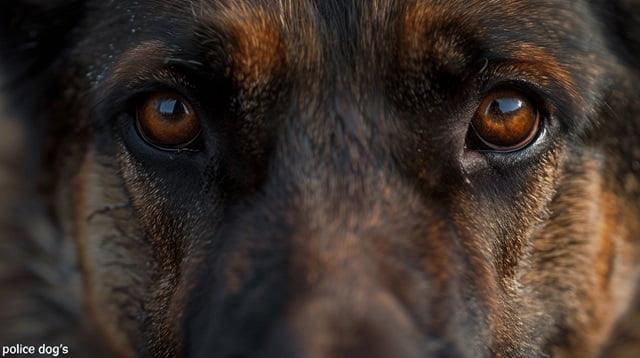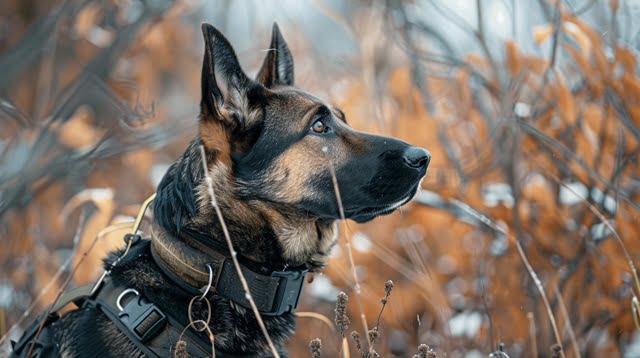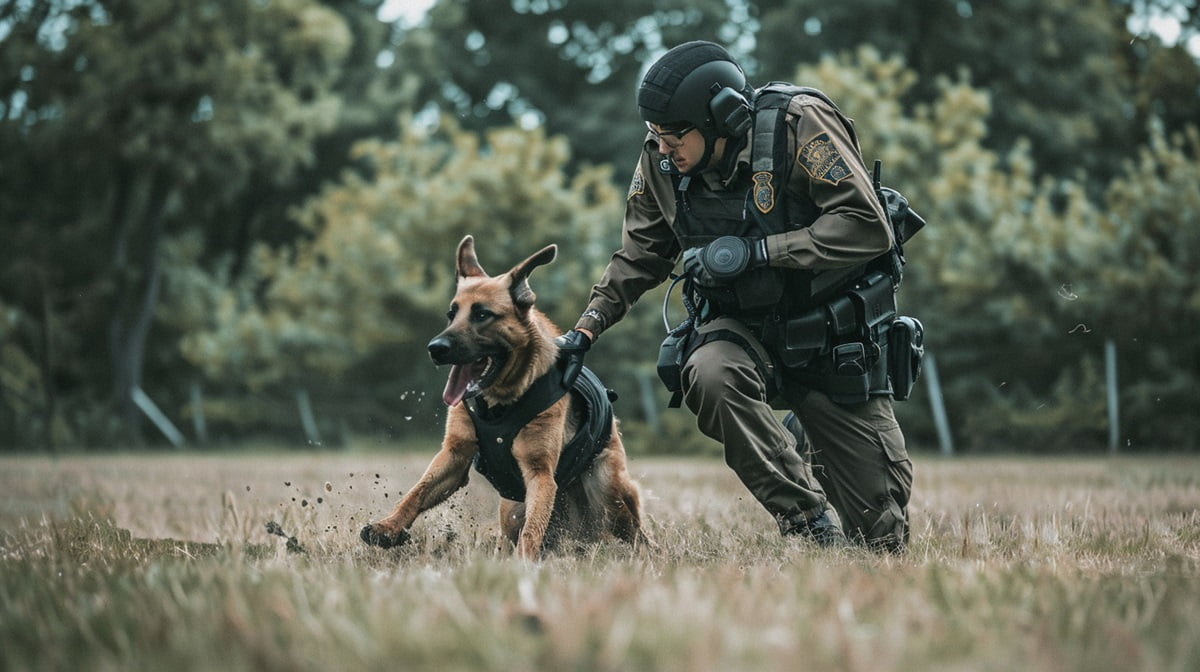Police dogs are the unsung heroes of law enforcement. They possess an incredible array of skills, from sniffing out contraband to tracking down missing persons, and even apprehending dangerous criminals. But have you ever wondered how these four-legged officers acquire their remarkable abilities? In this article, we’ll delve into the fascinating world of police dog training, exploring the factors that influence the duration of their education and the intricate process of transforming them into invaluable members of the force.
The question that often arises is: how long does it take to mold a regular pup into a highly skilled police dog? The answer isn’t as straightforward as you might think. It’s a journey influenced by a multitude of variables, each playing a crucial role in shaping the final outcome. We’ll dissect these factors, examine the different phases of training, and even uncover some little-known facts about the remarkable world of police K-9s.
So, whether you’re a dog enthusiast curious about the inner workings of police dog training or considering a career in law enforcement alongside a canine partner, buckle up for an informative and engaging exploration of this captivating topic.

Factors That Influence Police Dog Training Time
Variety of police dog breeds: German Shepherd, Belgian Malinois, Labrador Retriever
As mentioned, the duration of police dog training isn’t set in stone. It’s a dynamic process that can be influenced by several key factors. Understanding these variables is essential to grasp the intricacies of transforming a furry friend into a highly capable K-9 officer.

Breed: A Matter of Aptitude
Certain dog breeds are inherently predisposed to excel in police work. Their genetic makeup often includes traits like intelligence, trainability, energy levels, and a strong work drive. Breeds like German Shepherds, Belgian Malinois, and Dutch Shepherds are frequently chosen for their natural aptitude for tasks like tracking, apprehension, and detection work. While other breeds can be trained for police work, these specific breeds tend to have a shorter training timeline due to their innate abilities.
Age: Starting Young for Optimal Results
Police dog training typically commences when a dog is young, usually around 1-2 years old. At this stage, dogs are eager to learn and more adaptable to new experiences. Their minds are like sponges, soaking up information and commands with relative ease. However, don’t discount older dogs entirely. Some mature canines with the right temperament and drive can still be successfully trained for police work, although it might take slightly longer.
Type of Training: From Obedience to Specialization
The type of training a police dog undergoes significantly impacts the overall duration. It all starts with basic obedience training, where dogs learn essential commands like sit, stay, come, heel, and down. This foundation is crucial for all subsequent training.
Once a dog masters basic obedience, it progresses to specialized training tailored to its specific role. This could involve:
- Narcotics Detection: Training dogs to detect illegal substances like drugs.
- Explosives Detection: Equipping dogs to identify explosives and other hazardous materials.
- Tracking: Honing a dog’s ability to follow scent trails and locate missing persons or suspects.
- Apprehension: Preparing dogs for scenarios where they might need to restrain a suspect.
Each of these specializations requires additional time and focused training, often taking months or even years to perfect.
Individual Learning Pace: Every Dog is Unique
Just like humans, dogs have individual learning curves. Some are quick learners, grasping new concepts and commands rapidly, while others might require more patience and repetition. This inherent difference in learning pace can significantly affect the overall training timeline. A naturally gifted dog might complete training faster than one that needs a bit more time to master specific skills.
Understanding these factors is crucial for setting realistic expectations about the time it takes to train a police dog. It’s a multifaceted process where the dog’s breed, age, training type, and individual learning style all contribute to the final outcome.
The Intricate Journey of Police Dog Training
Training a police dog is a meticulously crafted process that demands dedication, expertise, and a deep understanding of canine behavior. It’s a journey that takes months or even years to complete, but the results are nothing short of remarkable. Let’s take a closer look at the various stages involved in shaping a regular dog into a highly skilled K-9 officer.
Basic Obedience Training: The Foundation
Every police dog’s journey begins with mastering the fundamentals of obedience. This phase is crucial as it establishes a strong bond between the dog and its handler while instilling essential commands. These commands include:
- Sit: The dog learns to sit on command, remaining in that position until released.
- Stay: The dog learns to remain stationary, even in distracting environments.
- Come: The dog learns to return to its handler immediately when called.
- Heel: The dog learns to walk alongside its handler in a controlled manner.
- Down: The dog learns to lie down on command and remain down until released.
These commands form the bedrock of all subsequent training. They provide the handler with control and ensure the dog’s safety and effectiveness in the field.
Specialized Training: Honing Specific Skills
Once a dog has mastered basic obedience, it embarks on specialized training tailored to its designated role. This phase is where the dog’s unique talents and abilities are honed to perfection. Let’s explore some of the common specializations:
Narcotics Detection
Dogs trained in narcotics detection become experts at sniffing out illegal substances like drugs. They are exposed to a wide range of scents, learning to identify specific odors associated with drugs like marijuana, cocaine, heroin, and methamphetamine. Their keen sense of smell is invaluable in law enforcement operations aimed at curbing drug trafficking.
Explosives Detection
These highly trained dogs are the frontline defense against explosives. They are taught to detect a vast array of explosive materials, from homemade bombs to commercial-grade explosives. Their ability to pinpoint hidden threats is crucial in ensuring public safety and preventing terrorist attacks.
Tracking
Tracking dogs are masters of following scent trails. They can track missing persons, suspects on the run, or even lost objects. Their noses are so sensitive that they can pick up on faint scent trails that are days or even weeks old. This skill is invaluable in search and rescue operations and criminal investigations.
Apprehension
Apprehension dogs are trained to assist law enforcement in detaining suspects. They are taught to apprehend individuals who pose a threat to public safety or resist arrest. These dogs are incredibly powerful and agile, and their presence alone can often deter criminal activity.

Socialization and Environmental Exposure
Socialization plays a pivotal role in a police dog’s development. From a young age, they are exposed to a wide range of environments, people, and situations. This exposure helps them become accustomed to the sights, sounds, and smells they will encounter on the job. It also ensures they remain calm and focused in high-stress situations.
Early training is essential in shaping a police dog’s behavior and temperament. Puppies are often enrolled in puppy classes to learn basic obedience and socialization skills. As they grow older, they are gradually introduced to the rigors of police work. This includes exposure to loud noises, crowded places, and even gunfire.
Positive Reinforcement: The Key to Success
Positive reinforcement is the cornerstone of police dog training. Trainers use rewards like praise, treats, and toys to motivate and encourage desired behaviors. This approach not only fosters a strong bond between the dog and its handler but also makes training a positive and enjoyable experience for both.
Finding a Qualified Trainer
The expertise of the trainer is paramount in shaping a successful police dog. Qualified trainers have a deep understanding of canine behavior, learning theory, and the specific requirements of police work. They know how to tailor training to each dog’s individual needs and ensure that the dog develops the skills necessary to excel in its role.
Additional Considerations: Beyond the Training Field
While the training process is undeniably crucial, several other factors come into play when considering the world of police dogs. These aspects extend beyond the training field and delve into the financial, emotional, and logistical commitments associated with these remarkable animals.
Cost of Training: A Significant Investment
Training a police dog is not a cheap endeavor. The cost can vary depending on the dog’s specialization, the training facility, and the geographical location. Basic obedience training alone can range from a few thousand dollars to tens of thousands. Specialized training, such as narcotics or explosives detection, can easily exceed $10,000 per dog.
These costs include not only the training itself but also the purchase price of the dog, veterinary care, food, equipment, and ongoing training and certifications. It’s a significant investment that requires careful financial planning and budgeting.
Commitment Required: A 24/7 Partnership
Owning and handling a police dog is a 24/7 commitment. These dogs aren’t just work partners; they become part of the handler’s family. They live with their handlers, share their homes, and often accompany them on vacations.
This commitment involves not only providing for the dog’s basic needs like food, water, and shelter but also ensuring they receive regular exercise, mental stimulation, and ongoing training. It’s a demanding lifestyle that requires dedication and a genuine love for dogs.
Rewards of Training: An Invaluable Bond
Despite the financial and emotional investments, the rewards of training a police dog are immeasurable. The bond between a handler and their K-9 partner is unlike any other. These dogs become trusted companions, loyal protectors, and invaluable assets in law enforcement.
Police dogs not only enhance the safety of their handlers but also contribute significantly to the community’s well-being. They help to apprehend criminals, detect dangerous substances, and locate missing persons. Their presence alone can deter crime and provide a sense of security to the public.
The satisfaction of witnessing a dog you’ve trained excel in its role is a feeling that few can describe. It’s a testament to the power of the human-animal bond and the incredible capabilities of these remarkable creatures.
FAQ
What specific qualities, beyond breed, make a dog suitable for police work?
While breed is a factor, a dog’s suitability for police work goes beyond genetics. Ideal candidates possess a unique blend of high energy and unwavering drive, essential for the demanding tasks they face. They must be exceptionally intelligent and trainable, quickly grasping complex commands and adapting to diverse situations. Strong nerves are crucial for remaining calm and focused under pressure, even in chaotic environments. Confidence and courage empower them to confront threats head-on, while good health and physical condition ensure they can perform their duties effectively. Lastly, social adaptability is key, as these dogs must interact appropriately with the public and other animals while maintaining their assertive nature
Can you explain the difference between “single-purpose” and “dual-purpose” police dogs, and how their training differs?
Single-purpose police dogs are specialists, laser-focused on one skill, such as narcotics or explosives detection. Their training is highly specialized, ensuring they become experts in their chosen field. On the other hand, dual-purpose dogs are versatile assets trained in both detection (e.g., narcotics or explosives) and patrol work (e.g., tracking, apprehension, handler protection). Their training is more comprehensive, requiring them to seamlessly switch between roles, making them invaluable for law enforcement. Naturally, due to the wider range of skills they must master, training for dual-purpose dogs is typically longer than that for single-purpose dogs.

My job is to make sure every fact is right and every article is a joy to read. I’m kind of like a dog trainer for information – I make it behave!

